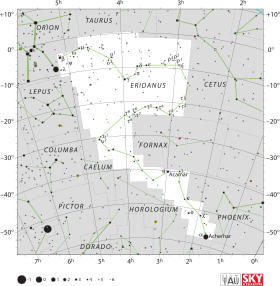LP 944-020
| Ascension droite | 03h 39m 35,2525s[1] |
|---|---|
| Déclinaison | −35° 25′ 43,628″[1] |
| Constellation | Fourneau |
| Magnitude apparente | 18,69 |
| Type spectral | M9 |
|---|
| Mouvement propre |
μα = +308,868 mas/a[1] μδ = +268,194 mas/a[1] |
|---|---|
| Parallaxe | 155,759 0 ± 0,099 1 mas[1] |
| Distance | 6,420 2 ± 0,004 1 pc (∼20,9 al)[1] |
| Magnitude absolue | 20,02 |
| Masse | < 0,08 M☉ |
|---|
Désignations
LP 944-020 est une naine brune de type spectral M9 située à 20,9 années-lumière de la Terre dans la constellation du Fourneau[3]. Elle fut observée pour la première fois en 1975 par Willem Jacob Luyten.
En 2012, c'était le 47e système stellaire connu le plus proche du Soleil[4]; en 2024, il est passé au 54e rang.
En 2007 on découvre du lithium dans son atmosphère[5].
- (en) A. G. A. Brown et al. (Gaia collaboration), « Gaia Data Release 2 : Summary of the contents and survey properties », Astronomy & Astrophysics, vol. 616, , article no A1 (DOI 10.1051/0004-6361/201833051, Bibcode 2018A&A...616A...1G, arXiv 1804.09365). Notice Gaia DR2 pour cette source sur VizieR.
- (en) LP 944-20 -- Low-mass star (M<1solMass) sur la base de données Simbad du Centre de données astronomiques de Strasbourg.
- Nancy G. Roman, « Identification of a Constellation From a Position », Publications of the Astronomical Society of the Pacific, vol. 99, no 617, , p. 695–699 (DOI 10.1086/132034, Bibcode 1987PASP...99..695R, lire en ligne). Requête VizieR spécifique à LP 944-020.
- "The 100 nearest star systems", Research Consortium on Nearby Stars (consulté 14 juillet 2018)
- Pavlenko, Ya. V., et al. (September 2007). "Lithium in LP944-20". Monthly Notices of the Royal Astronomical Society, Centre for Astrophysics Research, University of Hertfordshire, [1]


